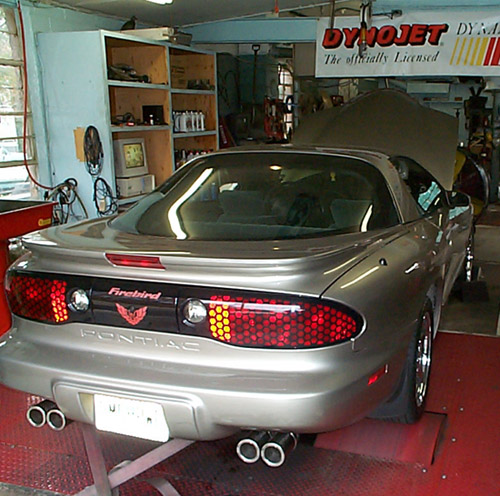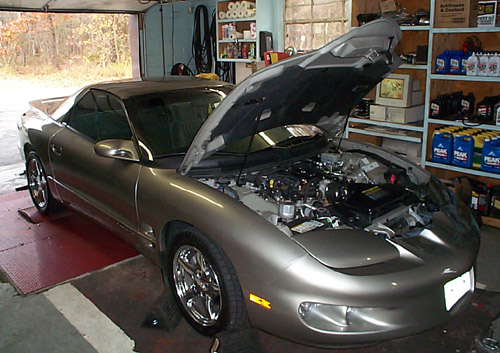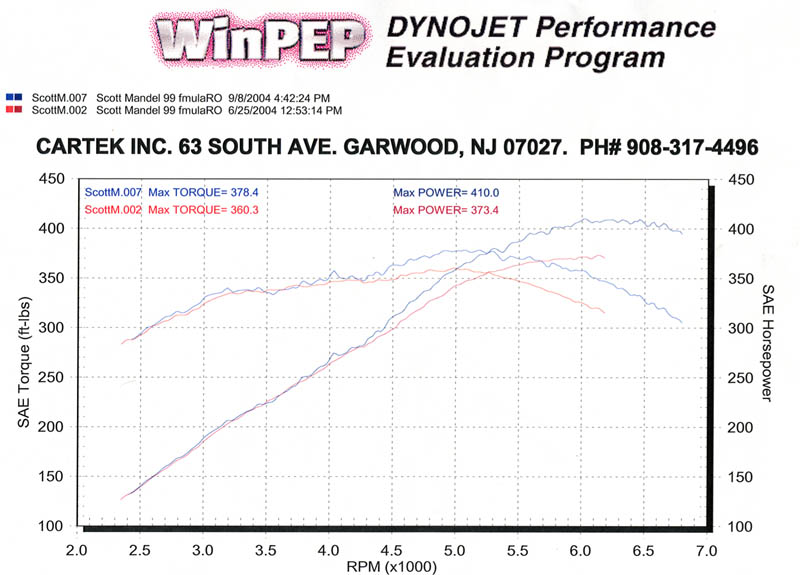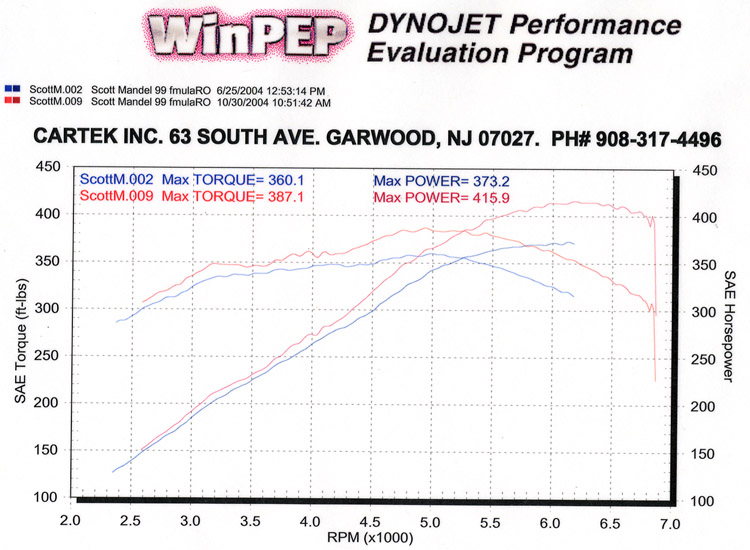


There were no changes, except for additional mileage. The car had 8000
miles on it for this test. The increase in horsepower resulted
from the additional break-in mileage as well as the computer adjusting to the
new exhaust and airbox lid.
Horsepower = 312.2 @ 5500 rpm.
Torque = 327.0 @ 4500 rpm.
The only change was the addition of a Granatelli Motor Sports (GMS) Mass
Air Flow (MAF) meter. The new meter was used on the car for approximately 1500
miles before it was dyno tested. The car had 11k miles at the time of this dyno
test.
Horsepower = 318.4 @ 5300 rpm.
Torque = 333.8 @ 4400 rpm.
It is interesting that the peak power came slightly before it peaked without
the new meter; an added benefit. Some of this gain is from the additional break-in
mileage.
Dyno'd the car again at Larocca's. Power was slightly down (to 315 hp) from the previous dyno.
I got a B1 cam!!! "Gold Jerry. GOLD!!". I have also added headers, intake and y pipe. See the "LS1 Modifications" page for pics and details.
Cartek did a great job of tuning my car. They used a software called "LS1edit" to fine tune the air/fuel ratio, rev-limiter, idle, timing, and various other parameters. This first graph shows the difference the tuning made. Before the tune, it made 375 hp and 355 TQ. After Julio worked his magic, my car made almost 386 hp and 365 TQ. I still have stock heads that have never been off the motor!
But as the next graph shows, my fuel pump is not keeping up with the new horsepower levels. The bottom part of the following graph shows the fuel pressure dipping to below 50 lbs. That is no good. A new pump will be in there soon, and we'll see if that increases horsepower even more.
Jay Fisher Pontiac replaced the stock fuel pump and Cartek finished the LS1edit dyno-tuning session. The air/fuel ratio is now in a safe range. An added benefit is an increase of 5 ft-lbs. of torque to 370. Horsepower increased slightly (by 2hp) to 387.5 hp. An interesting side note is that the SAE correction factor was .98 and the actual (uncorrected) peak horsepower was 396 and actual (uncorrected) peak torque was 379. As a matter of fact, the car is now making more power everywhere on the graph when compared to the dyno graph of the bad fuel pump. Below is the SAE corrected dyno graph:
Before the fuel pump change, the car didn't make 350 TQ until 4300 RPM. But with the new fuel pump, the car makes 350 TQ at 3800 RPM. Before the fuel pump change, the car made 350 hp at 5300 RPM. With the new fuel pump, 350 hp is made at 5000 RPM. This benefit will also be reflected in my quarter mile times.
Due to the generousity of Ken from East Side Performance, I found out that my car was running very rich. The air/fuel ratio was about 11.5 to 1, and subsequently, power output was way down. So i took the car back to Cartek for more of Julio's magic touch. Keep in mind that the car was now equipped with a Moser Engineering 12 bolt rear-end with 4.10 gears. This new rear has bigger and stronger internals than the stock ten bolt (more rotating mass) and obviously will lower any power levels slightly because of that. Immediately before the tune, i replaced the stock 1999 fuel injectors, rated at 26.5 lbs/hr, with injectors from a stock 1998 camaro (thanx PETE!!!) which are rated at 28 lbs./hr.
While the was being tuned on the dyno, I recorded many parameters using ATAP software. You can see in the "Injector Pulse Width" column that the bigger injectors are working less than the smaller injectors which they replaced, which is good. ATAP LOGS
Cartek installed their stage II ported heads on my formula.
they are an older design, but not too old since they are still 241 castings. no other mods since my last dyno. i gained 37 HP and 18 TQ at the peaks.
they used conventional 10-40 oil. It was really hot in the shop and the garage door was shut to keep the noise to a minimum (damn neighbors). i was sweating just standing there. i think the engine temp was 190. They told me to redyno with more miles on it and when temps are more in my favor.
before they did the head swap, they did a leakdown test. #5 was 13% and #6 was 9%. the rest were between 3-5%.

10/30/04 update:
I redyno'd to check the tuning since we tuned in hot weather. Other changes were a switch to Royal Purple synthetic oil 10w-30 (from normal dino oil 10w-30), added the bullet muffler with the cutout right before the I-pipe goes over the axle, and of course the outside temp was much cooler (72 degrees for this pull). I gained 6 hp and 8 tq.

Click here to see some other sweet LS-1 F-bodies and to find links to LS-1 related websites.
Return to the top of the page.